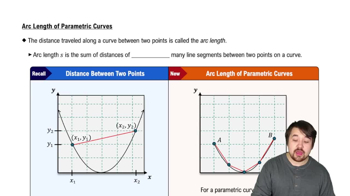Let ƒ(𝓍) = c, where c is a positive constant. Explain why an area function of ƒ is an increasing function.
Table of contents
- 0. Functions7h 54m
- Introduction to Functions16m
- Piecewise Functions10m
- Properties of Functions9m
- Common Functions1h 8m
- Transformations5m
- Combining Functions27m
- Exponent rules32m
- Exponential Functions28m
- Logarithmic Functions24m
- Properties of Logarithms36m
- Exponential & Logarithmic Equations35m
- Introduction to Trigonometric Functions38m
- Graphs of Trigonometric Functions44m
- Trigonometric Identities47m
- Inverse Trigonometric Functions48m
- 1. Limits and Continuity2h 2m
- 2. Intro to Derivatives1h 33m
- 3. Techniques of Differentiation3h 18m
- 4. Applications of Derivatives2h 38m
- 5. Graphical Applications of Derivatives6h 2m
- 6. Derivatives of Inverse, Exponential, & Logarithmic Functions2h 37m
- 7. Antiderivatives & Indefinite Integrals1h 26m
- 8. Definite Integrals4h 44m
- 9. Graphical Applications of Integrals2h 27m
- 10. Physics Applications of Integrals 3h 16m
- 11. Integrals of Inverse, Exponential, & Logarithmic Functions2h 34m
- 12. Techniques of Integration7h 41m
- 13. Intro to Differential Equations2h 55m
- 14. Sequences & Series5h 36m
- 15. Power Series2h 19m
- 16. Parametric Equations & Polar Coordinates7h 58m
9. Graphical Applications of Integrals
Area Between Curves
Problem 8.7.86b
Textbook Question
Let L(c) be the length of the parabola f(x) = x² from x = 0 to x = c, where c ≥ 0 is a constant.
b. Is L concave up or concave down on [0, ∞)?
 Verified step by step guidance
Verified step by step guidance1
Step 1: Recall the formula for the arc length of a curve y = f(x) from x = a to x = b: \( L = \int_a^b \sqrt{1 + \left( \frac{dy}{dx} \right)^2} dx \). Here, \( f(x) = x^2 \), so \( \frac{dy}{dx} = 2x \).
Step 2: Substitute \( \frac{dy}{dx} = 2x \) into the arc length formula. This gives \( L(c) = \int_0^c \sqrt{1 + (2x)^2} dx \), which simplifies to \( L(c) = \int_0^c \sqrt{1 + 4x^2} dx \).
Step 3: To determine whether \( L(c) \) is concave up or concave down, compute the first derivative \( L'(c) \) and the second derivative \( L''(c) \). Start by differentiating \( L(c) \) with respect to \( c \). Using the Fundamental Theorem of Calculus, \( L'(c) = \sqrt{1 + 4c^2} \).
Step 4: Differentiate \( L'(c) = \sqrt{1 + 4c^2} \) to find \( L''(c) \). Use the chain rule: \( L''(c) = \frac{d}{dc} \sqrt{1 + 4c^2} = \frac{1}{2\sqrt{1 + 4c^2}} \cdot 8c \), which simplifies to \( L''(c) = \frac{4c}{\sqrt{1 + 4c^2}} \).
Step 5: Analyze the sign of \( L''(c) \) on \([0, \infty)\). Since \( c \geq 0 \) and \( \sqrt{1 + 4c^2} > 0 \), \( L''(c) > 0 \) for all \( c \geq 0 \). Therefore, \( L(c) \) is concave up on \([0, \infty)\).
 Verified video answer for a similar problem:
Verified video answer for a similar problem:This video solution was recommended by our tutors as helpful for the problem above
Video duration:
4mPlay a video:
Was this helpful?
Key Concepts
Here are the essential concepts you must grasp in order to answer the question correctly.
Arc Length of a Curve
The arc length of a curve defined by a function f(x) from x = a to x = b is calculated using the formula L = ∫[a to b] √(1 + (f'(x))²) dx. For the parabola f(x) = x², we first need to find its derivative f'(x) = 2x, which will be used in the arc length formula to determine L(c) from 0 to c.
Recommended video:

Arc Length of Parametric Curves
Concavity
Concavity refers to the direction in which a curve bends. A function is concave up on an interval if its second derivative is positive, indicating that the slope of the tangent line is increasing. Conversely, it is concave down if the second derivative is negative. Understanding concavity helps in analyzing the behavior of the length function L(c) as c varies.
Recommended video:

Determining Concavity Given a Function
Second Derivative Test
The second derivative test is a method used to determine the concavity of a function. By computing the second derivative of L(c), we can assess whether it is positive or negative over the interval [0, ∞). This test is crucial for answering whether L(c) is concave up or down, providing insights into the nature of the length of the parabola as c increases.
Recommended video:

The Second Derivative Test: Finding Local Extrema

 5:23m
5:23mWatch next
Master Finding Area Between Curves on a Given Interval with a bite sized video explanation from Patrick
Start learningRelated Videos
Related Practice
Textbook Question
21
views
